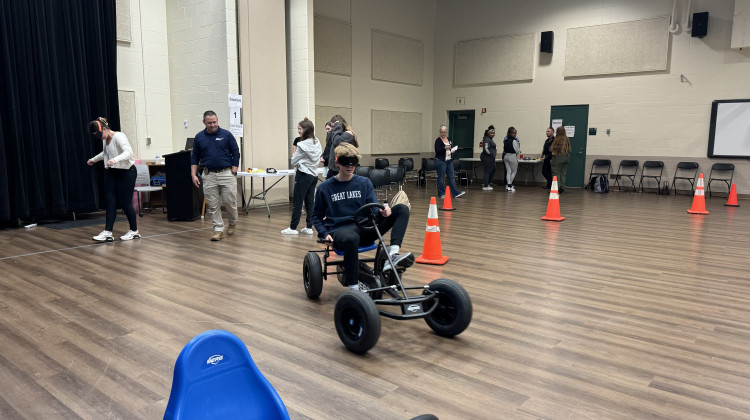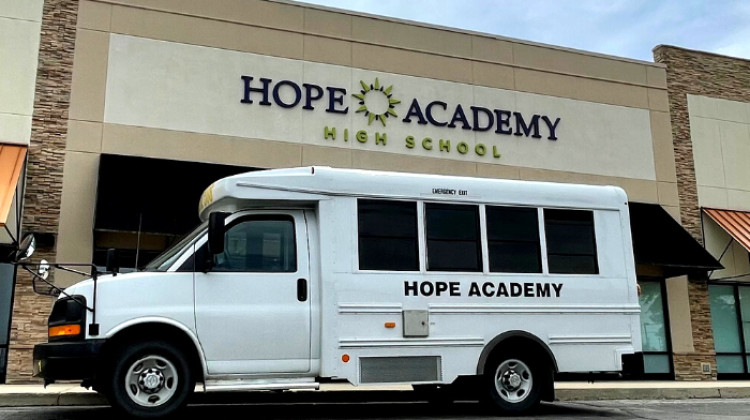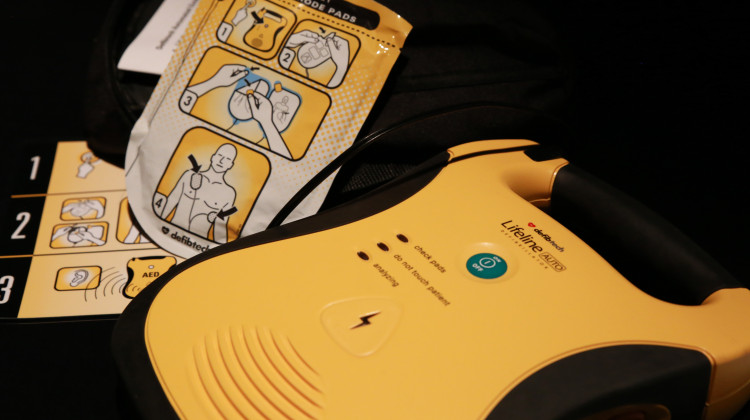
Students at Westfield High School participated in impaired driving simulations led by law enforcement officials. It's part of an effort to raise awareness about the dangers of driving under the influence of substances.
Elizabeth Gabriel / Side Effects Public MediaEvery day, about 37 people in the United States die in drunk driving car crashes, according to the National Highway Traffic Safety Administration. That's one person every 39 minutes. And the price tag is significant: a staggering $58 billion in medical expenses, legal costs and lost productivity due to premature death.
Among U.S. children, car crashes are the leading cause of death, with more than 156,000 young people injured in alcohol-related crashes in 2022.
A recent survey found that nearly 1 in every 6 teens say they’ve been a passenger of a driver who wasn’t sober. That’s why some schools are taking steps to raise awareness among their students.
“We've done mock crashes,” said Billy Adams, a drug recognition expert for the Westfield Police Department who works with local Indiana schools. “We've done programs where we walk the kids through the court system and show them what a trial looks like after a kid was responsible for hurting or killing somebody.”
Adams leads some experiential activities at Westfield High School to try to simulate how impaired driving affects the driver’s motor function.
Several weeks before summer break, Adams set up four different stations at a recreational room on campus.
The first station seemed simple. About 25 children took turns trying to walk in a straight line –– an activity that aims to mimic staying within the white lines on a road. At first, they did it pretty easily. But then they put on what looked like ski goggles, which are meant to simulate drunk driving by making the room slightly different colors and causing double vision.
That’s when things got tough, said Elisabeth Snowden, a rising senior.
“I'm thinking, ‘I got this,’” said Snowden, who was certain she wasn’t going to walk off the line. But wearing the goggles, she didn’t even get her big toe on the white strip.
“And then I literally did exactly what they said I was going to do. I will say that was probably the most shocking thing.”

Spreading awareness about the dangers of impaired driving starts with parents, said Barbara Banz, an assistant professor of emergency medicine at Yale University. She said some parents may drive after having one drink, which can set a bad example for kids since small amounts of alcohol can still affect someone's driving.
“Hearing young people talk in qualitative studies about when they stop themselves from driving after drinking, it's [at] that very extreme level,” Banz said. “It’s the falling over, it's the throwing up, it's the blackout –– that's when they're saying, ‘I can't drive anymore.’ It's not at the point of one or two drinks.”
Substances like alcohol and marijuana can slow a person’s reactions and impair their fine motor skills, coordination, judgment and balance. The Westfield teens got a little taste of that during the simulation, said Adams.
“Some of them did make comments of, ‘What if I just close my eyes, I can walk on the line fine,’” said Adams. “Well, you can't close your eyes and drive,” he would tell them.
Studies show adolescents who previously reported driving under the influence were more likely to have DUI charges as adults. Early awareness could save lives but school districts struggle to determine the best way to do so, said Bonnie Halpern-Felsher, a developmental psychologist with Stanford University.
She cautions school districts against using abstinence-only learning styles, which involve scare tactics like showing someone dead in a seatbelt.
“The problem with scaring them or saying if you do X, Y will definitely happen –– so if you drive drunk, you will get into an accident –– is if none of those things happen, it’s as if we've lied to the teen and they don't believe us anymore,” Halpern-Felsher said.
She hopes simulations like the one at Westfield High School could work. But there is still not enough recent research to show how effective they are. Halpern-Felsher’s research team plans to release a curriculum that teaches teens about the harms of driving while under the influence of cannabis.
She suggests teachers and parents stress the importance of knowing how different substances affect people, being in safe places away from vehicles or open windows, putting a person on their side if they’re unconscious and calling 911 if someone is sick or passes out.
Jesse West IV, a teenager at Westfield, said he doesn’t think the school activity will end impaired driving. But he’s hopeful the simulation will at least reduce it.
“If I have a friend that's drinking, maybe I shouldn't even be in the car with them,” West said. “And I never really understood how serious it can be, and how reliant you are on muscle memory. And our age, we [are] only, at most, two years into driving. So that muscle memory isn't going to be good enough, and I feel like that's very dangerous. So I wouldn't get in the car with anybody drinking.”
Contact health reporter Elizabeth Gabriel at egabriel@wfyi.org.
Side Effects Public Media is a health reporting collaboration based at WFYI in Indianapolis. We partner with NPR stations across the Midwest and surrounding areas — including KBIA and KCUR in Missouri, Iowa Public Radio, Ideastream in Ohio and WFPL in Kentucky.
 DONATE
DONATE






 Support WFYI. We can't do it without you.
Support WFYI. We can't do it without you.